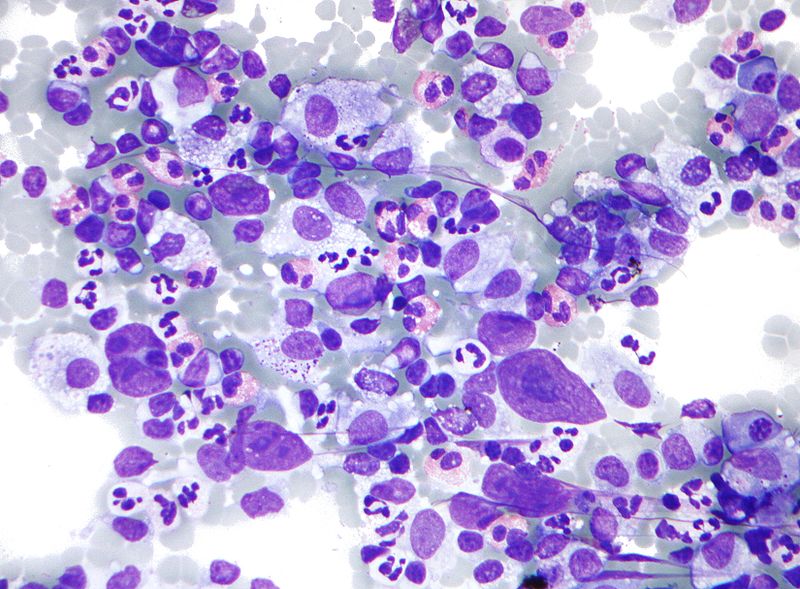B-cell lymphoma pathophysiology: Difference between revisions
No edit summary |
No edit summary |
||
| Line 3: | Line 3: | ||
{{CMG}};{{AE}}{{SM}} | {{CMG}};{{AE}}{{SM}} | ||
==Overview== | |||
==Pathophysiology== | ==Pathophysiology== | ||
===Genetics=== | |||
[[Chromosomal translocation]]s involving the immunoglobulin heavy locus (IGH@) is a classic cytogenetic abnormality for many B-cell lymphomas, including [[follicular lymphoma]], [[mantle cell lymphoma]] and [[Burkitt's lymphoma]]. In these cases, The immunoglobulin heavy locus forms a [[fusion protein]] with another protein that has pro-proliferative or anti-apoptotic abilities. The enhancer element of the immunoglobulin heavy locus, which normally functions to make B cells produce massive production of antibodies, now induces massive transcription of the fusion protein, resulting in excessive pro-proliferative or anti-apoptotic effects on the B cells containing the fusion protein. In [[Burkitt's lymphoma]] and [[mantle cell lymphoma]], the other protein in the fusion is [[c-myc]] (on chromosome 8) and [[cyclin D1]]<ref name=jy>{{cite journal |author=Li JY, Gaillard F, Moreau A, ''et al.'' |title=Detection of translocation t(11;14)(q13;q32) in mantle cell lymphoma by fluorescence in situ hybridization |journal=Am. J. Pathol. |volume=154 |issue=5 |pages=1449–52 |year=1999 |month=May |pmid=10329598 |pmc=1866594 |doi= 10.1016/S0002-9440(10)65399-0|url=}}</ref> (on chromosome 11), respectively, which gives the [[fusion protein]] pro-proliferative ability. In [[follicular lymphoma]], the fused protein is [[Bcl-2]] (on chromosome 18), which gives the fusion protein anti-apoptotic abilities. | |||
===Microscopic Pathology=== | ===Microscopic Pathology=== | ||
Shown below is a microscopic image of Hodgkins Lymphoma which is a type of B cell lymphoma.Lymph node FNA specimen(Field's stain) | Shown below is a microscopic image of Hodgkins Lymphoma which is a type of B cell lymphoma.Lymph node FNA specimen(Field's stain) | ||
| Line 16: | Line 17: | ||
[[Image:800px-Hodgkin_lymphoma_cytology_large.jpg|200px]] | [[Image:800px-Hodgkin_lymphoma_cytology_large.jpg|200px]] | ||
===Video=== | ===Video=== | ||
Revision as of 13:02, 20 August 2015
|
B-cell lymphoma Microchapters |
|
Diagnosis |
|---|
|
Treatment |
|
Case Studies |
|
B-cell lymphoma pathophysiology On the Web |
|
American Roentgen Ray Society Images of B-cell lymphoma pathophysiology |
|
Risk calculators and risk factors for B-cell lymphoma pathophysiology |
Editor-In-Chief: C. Michael Gibson, M.S., M.D. [1];Associate Editor(s)-in-Chief: Shivali Marketkar, M.B.B.S. [2]
Overview
Pathophysiology
Genetics
Chromosomal translocations involving the immunoglobulin heavy locus (IGH@) is a classic cytogenetic abnormality for many B-cell lymphomas, including follicular lymphoma, mantle cell lymphoma and Burkitt's lymphoma. In these cases, The immunoglobulin heavy locus forms a fusion protein with another protein that has pro-proliferative or anti-apoptotic abilities. The enhancer element of the immunoglobulin heavy locus, which normally functions to make B cells produce massive production of antibodies, now induces massive transcription of the fusion protein, resulting in excessive pro-proliferative or anti-apoptotic effects on the B cells containing the fusion protein. In Burkitt's lymphoma and mantle cell lymphoma, the other protein in the fusion is c-myc (on chromosome 8) and cyclin D1[1] (on chromosome 11), respectively, which gives the fusion protein pro-proliferative ability. In follicular lymphoma, the fused protein is Bcl-2 (on chromosome 18), which gives the fusion protein anti-apoptotic abilities.
Microscopic Pathology
Shown below is a microscopic image of Hodgkins Lymphoma which is a type of B cell lymphoma.Lymph node FNA specimen(Field's stain) The micrograph shows a mixture of cells commonly seen in Hodgkins lymphoma:
- Eosinophils
- Reed Sternberg cells
- Plasma cells
- Histiocytes
Video
Shown below is a video of diffuse large B cell lymphoma {{#ev:youtube|9gEo7si6jtc}}
References
- ↑ Li JY, Gaillard F, Moreau A; et al. (1999). "Detection of translocation t(11;14)(q13;q32) in mantle cell lymphoma by fluorescence in situ hybridization". Am. J. Pathol. 154 (5): 1449–52. doi:10.1016/S0002-9440(10)65399-0. PMC 1866594. PMID 10329598. Unknown parameter
|month=ignored (help)
